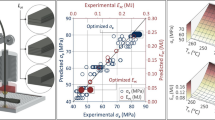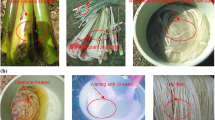Abstract
Dry and wet cotton linters were compressed under elevated pressure in a home-made Bridgman anvil press designed to reach 2.5 GPa and 180 °C. The structural organisation of cotton was changed under the joint action of temperature and pressure. Cotton having high moisture content shows that only a thin surface layer is partially destructured to a compact mat of nanofibres, while the initial cotton fibres are only deformed inside the sample. For dried cotton, the whole sample undergoes a destructuration into a compact mat of nanometre-sized fibres. The mechanical properties were studied by nano-indentation and dynamic mechanical analysis. Compressed dry cotton has higher modulus (10.3 GPa) than wet cotton (6.8 GPa). We postulate that the transverse elastic modulus of cotton microfibrils is around the value of 10 GPa. This work showed that nano-sized fibrils can also be separated in the solid state without flow, and re-compacted to form a solid object.









Similar content being viewed by others
References
Baley C (2002) Analysis of the flax fibres tensile behaviour and analysis of the tensile stiffness increase. Compos A 33:939–948
Baley C, Perrot Y, Busnel F, Guezenoc H, Davies P (2006) Transverse tensile behaviour of unidirectional plies reinforced with flax fibres. Mater Lett 60(24):2984–2987
Bassett DC, Block S, Piermarini GJ (1974) High pressure phase of polyethylene and chain extended growth. J Appl Phys 45(10):4146–4150
Cichocki FR Jr, Thomason JL (2002) Thermoelastic anisotropy of a natural fiber. Compos Sci Technol 62:669–678
Cuissinat C, Navard P (2006) Swelling and dissolution of cellulose part 1: free floating cotton and wood fibres in N-methylmorpholine-N-oxide-water mixtures. Macromol Symp 244(1):1–18
Figueiredo A, Evtuguin D, Saraiva J (2010) Effect of high pressure treatment on structure and properties of cellulose in eucalypt pulps. Cellulose 17(6):1193–1202
Gindl W, Reifferscheid M, Adusumalli R-B, Weber H, Röder T, Sixta H, Schöberl T (2008) Anisotropy of the modulus of elasticity in regenerated cellulose fibres related to molecular orientation. Polymer 49(3):792–799
Kokorevics A, Gravitis J (1997) Cellulose depolymerization to glucose and other wáter soluble polysaccharides by shear deformation and high pressure treatment. Glycoconj J 14(5):669–676
Maurin R, Perrot Y, Bourmaud A, Davies P, Baley C (2009) Seawater ageing of low styrene emission resins for marine composites: mechanical behaviour and nano-indentation studies. Compos A 40(8):1024–1032
Oliveira SCT, Figueiredo AB, Evtuguin DV, Saraiva JA (2012) High pressure treatment as a tool for engineering of enzymatic reactions in cellulosic fibres. Bioresour Technol 107:530–534
Rogovina SZ, Vikhoreva GA (2006) Polysaccharide-based polymer blends: methods of their production. Glycoconj J 23(7):611–618
Rogovina SZ, Zhorin VA, Enikolopian NS (1995) Modification of cellulose in conditions of plastic flow under pressure. J Appl Polym Sci 57(4):439–447
Schroeter J, Felix F (2005) Melting cellulose. Cellulose 12(2):159–165
Schroeter J, Felix F (2011) Method for plastic deformation of polymers by electromagnetic radiation. US Patent 7,901,612 B2
Yang B, Jiang Y, Wang R, Zhao M, Sun J (2009) Ultra-high pressure treatment effects on polysaccharides and lignins of longan fruit pericarp. Food Chem 112(2):428–431
Yasuniwa M, Nakafuku C (1987) High pressure crystallization of ultra-high molecular weigth polyethylene. Polym J 19(7):805–813
Zhorin VA, Kiselev MR, Zelenetskii AN, Rudakova TA (2010) Calorimetric investigation of some polysaccharides subjected to high-pressure plastic deformation. Polym Sci Ser A 52(4):398–406
Acknowledgments
The work was performed in the frame of the Industrial Chair in Bioplastics supported by Arkema, l’Oréal, Nestlé, PSA Peugeot-Citroën and Schneider Electric. The authors thank staff from Design department and Workshop of CEMEF for having constructed the press.
Author information
Authors and Affiliations
Corresponding author
Additional information
Cemef is member of the European Polysaccharide Network of Excellence (www.epnoe.eu).
Rights and permissions
About this article
Cite this article
Privas, E., Felder, E. & Navard, P. Destructuration of cotton under elevated pressure. Cellulose 20, 1001–1011 (2013). https://doi.org/10.1007/s10570-013-9924-4
Received:
Accepted:
Published:
Issue Date:
DOI: https://doi.org/10.1007/s10570-013-9924-4




